The future is in your hands.
If you want to enter the crypto world, take a look at the following content and see what might help you.
One, what is trading coins? First, understand the underlying logic.
Many people find trading coins mysterious; in fact, it's similar to 'trading stocks' or 'trading shoes.' The core concept can be summed up in four words: buy low and sell high. For example, if you think Bitcoin will rise, buy one at 30,000 USDT and sell it when it rises to 40,000 USDT, netting a profit of 10,000 USDT (about 70,000 RMB). However, compared to traditional investments, the crypto market has two major characteristics:
24-hour trading: No market close, can operate even during the night; suitable for night owls (but can also cause insomnia).
Unlimited fluctuations: Doubling or halving in a day is not unusual; proceed with caution if you have a weak heart.
Two, how to choose an exchange? Remember three survival principles.
Exchanges are like 'markets' for buying and selling coins; choosing the wrong one can lead to total loss. Newbies should remember:
Only choose top platforms: Binance and OKX are the top two globally; domestic users should prioritize OKX (supports WeChat/Alipay deposits, the interface is fully in Chinese, and it is the most user-friendly for beginners).
Don't touch small exchanges: Some platforms offer '100% rebate' to attract you, but when they run away, the customer service won't respond.
Complete identity verification: Although it's troublesome, it unlocks higher limits and features, essentially insuring your account.
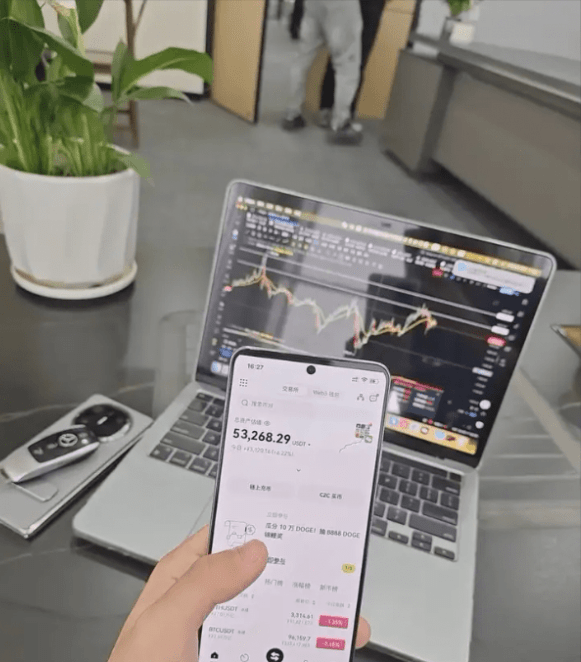
Three, USDT—the 'grain ticket' of the crypto world.
The most confusing point for newcomers: RMB cannot directly buy Bitcoin! You must first buy USDT with RMB (1 USDT ≈ 1 USD). It's like exchanging chips in a casino; USDT is the 'universal chip' in the crypto world.
Three major channels to buy USDT.:
① OKX C2C area: Choose merchants with 'Alipay payment' + '99% transaction rate,' funds arrive within 5 minutes.
② Binance quick buy: Suitable for small amounts, but the minimum single transaction is 500 yuan.
③ Friend transfer: The safest with acquaintances, but be cautious of fake USDT.
Four, 30 industry jargon terms you must know (to avoid being cut).
Understand these, and you won't be fooled by old traders:
Position management: Full position (all-in), half position (leave an exit), empty position (wait and see).
Operational strategy: Take profit (run when you make money), stop-loss (exit when losses hurt), induce buying (false rise to trick you into taking over).
Market judgment: Bull market (rises every day), bear market (falling and not recognized), pin bar (price suddenly plummets or soars).
Five, ranking of rookie self-destructive behaviors.
Use bloody experiences to help you avoid pitfalls:
First place: Playing with contract leverage.
10x leverage to double your money? A 10% drop leads to liquidation! I've seen too many people lose half a year's salary in one night.
Second place: All-in on Dogecoin.
What 'Dogecoin killer' or 'Mooncoin'? The ones shouting in the group are all shills; once you take over, they will withdraw.
Third place: Following the herd.
Entering the market only after seeing news about 'Bitcoin's surge'? You are likely to buy at the highest point.
Welcome to follow the public account (Chain Shang Rui Qian), where you can watch live trading for learning and communication, and you can clearly understand the market direction and strategies. No matter what style the market is, knowing in advance allows you to better master it!
In the crypto world, there is indeed a timeless trading strategy, which is also a foolproof technique that retail investors can easily utilize—pure practical advice!
In trading, you don't always need an extremely complex or professional method to achieve success. Instead, you just need an effective strategy. Utilizing one of the oldest and simplest trading tools—moving averages—might be a good start.
If you are a scalper or use other short-term strategies, using moving averages on the 15-minute chart is highly recommended. Among them, the 20 EMA is the most useful moving average on the 15-minute chart because, in multi-day trends, the price follows the moving average's movement most accurately. In other words, you can easily identify trends through it.
How does the 20 EMA strategy work?
The main advantage of the 20 EMA trading strategy is that even novice traders can easily get started. The only tool you need is the 20 EMA, and it applies to any currency pair and any time frame.
In a downtrend, the overall expectation for the price is to decline. But at some point, you will see the price change direction to test the 20 EMA line. If the downtrend is strong enough, the 20 EMA will push the price back down. This phenomenon is called a 'pullback,' and it may happen once or several times until the 20 EMA is effectively broken.
Therefore, the core function of the 20 EMA strategy is to act as a 'rebound line' for candlesticks. As a trader, you should wait for and use the moment when the price pulls back to the 20 EMA line.
Here’s a key detail to note: You only need to focus on one very specific candlestick—that is the first candlestick that touches the EMA line after the price has moved away from it for a while. Remember, if the next candlestick continues to closely follow the EMA line, that’s not a good signal. Once you capture the correct signal, it’s a good time to open a position.
For example:
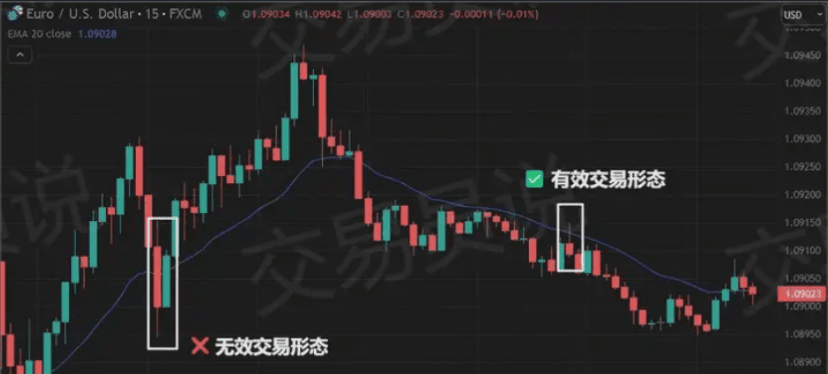
The basic principles of the 20 EMA strategy are as follows:
When the price closes above the 20 EMA, the market is in an uptrend; when the price closes below the 20 EMA, the market is in a downtrend.
The first candlestick that touches the 20 EMA after the trend changes direction is called the signal candlestick. You only need to focus on this candlestick because your entry position depends on the highest and lowest points of this signal candlestick.
In an uptrend, you should set your buy stop-loss order just above 1-2 points of the signal candlestick's highest point. If the next candlestick does not trigger your order, you should cancel that order.
Conversely, in a downtrend, you should set your sell stop-loss order just below 1-2 points of the signal candlestick's lowest point. If the next candlestick does not trigger the order, you should cancel that order.
In long trades, the stop loss should be set a few points below the lowest point of the signal candlestick (at least 5-10 points, depending on the time frame you are using); in short trades, the stop loss should be set a few points above the highest point of the signal candlestick.
Here’s an example of establishing a short position based on the previous chart:
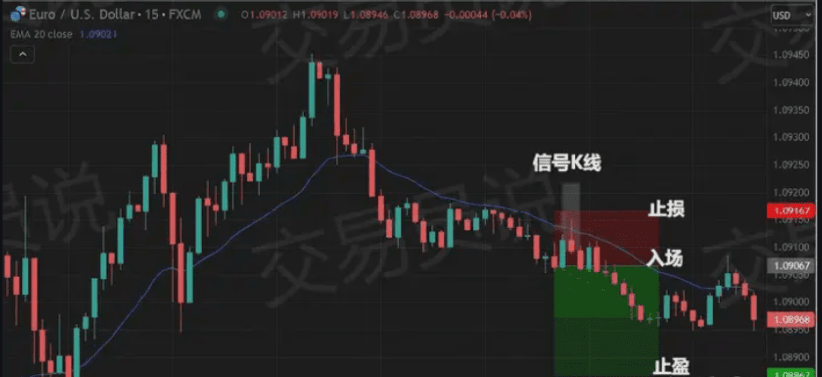
In the above picture, on the 15-minute chart for EUR/USD, the lowest point of the signal candlestick is 1.09087; therefore, the sell stop-loss order is set 2 points below it. The next candlestick continues to fall, so the order is triggered at 1.09067. According to the rules, the stop-loss is set 10 points above the signal candlestick, which is 1.09167. As for taking profit, this example adopts a 1:2 risk-reward ratio, so the take profit is set 20 points below the entry price, which is 1.08867.
Use daily charts to identify major trends.
You definitely don't want to jump in when the trend is unclear, risking losing money. That's why some traders choose to switch to other time frames to filter the market. They hope to identify trends in advance and ensure that the trend is strong enough. Once they confirm the price direction on the daily chart, it becomes much easier to look for entry opportunities on the 15-minute chart.
What should be done?
First, to identify the trend, you need to set several rules on the chart. The goal is to discern the direction of price movement. Don't worry; these rules apply to both uptrends and downtrends and are effective across different time frames:
◎ Ensure that the price has been continuously rising or falling for several days and that at least one higher low (HL) appears in an uptrend, and at least one lower high (LH) appears in a downtrend.
◎ In an uptrend, the 20 EMA line should present a 2 o'clock direction or a steeper upward angle; in a downtrend, the 20 EMA should present a 4 o'clock downward angle.
◎ In an uptrend, the price should significantly break through resistance; in a downtrend, the price should significantly break below support.
After this, switch to the 15-minute chart and focus on the following two potential buying conditions under upward trends:
1. Breakthroughs in support/resistance on the daily chart.
If the price is clearly moving along the 20 EMA, it indicates that it is in an ideal trading position.
2. Significant fluctuations around support/resistance areas.
This situation is relatively safer because the price has confirmed its momentum and is continuously moving in the expected direction. Therefore, when the price touches and stabilizes near the 20 EMA, it's a good time to enter.
How to use the 20 EMA to find quality entry points.
Using the 20 EMA (Exponential Moving Average) to determine a quality entry point is relatively simple. First, identify the trend, find support and resistance, and then enter when the price pulls back to these levels.
1. Identify trends.
Using the 20 EMA indicator to identify trends is quite straightforward. You just need to observe the position of the EMA line relative to the current price movement.
◎ If the EMA line is below the current price, it indicates an uptrend.
◎ Conversely, if the EMA line is above the current price, it indicates a downtrend.
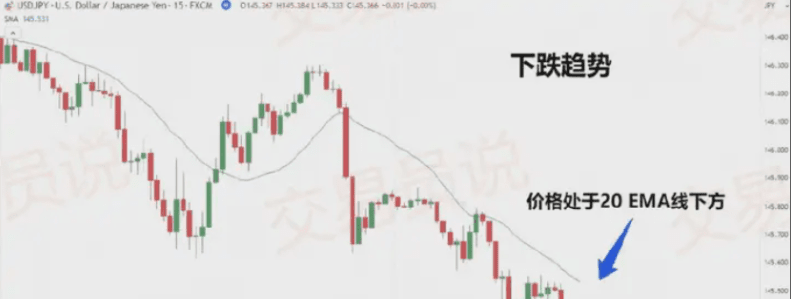
2. Look for support or resistance.
Once you determine the current trend, the next step is to identify important support or resistance levels. As emphasized earlier, we focus on the dynamic support and resistance from the 20 EMA line.
◎ In a downtrend, the 20 EMA line acts as a resistance level.
◎ Conversely, in an uptrend, the 20 EMA line acts as a support level.
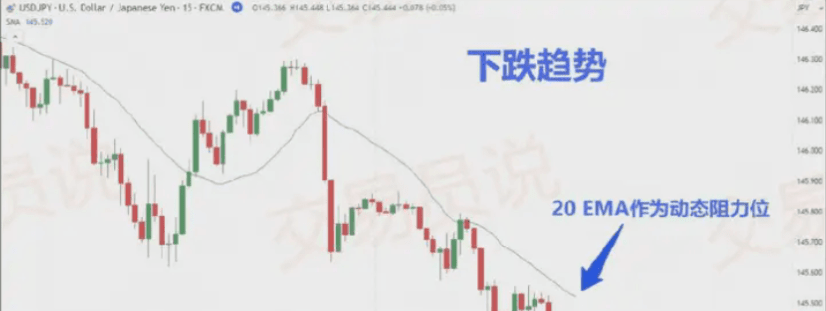
3. Wait for a pullback.
Next, you need to patiently wait for the price to pull back to support or resistance levels, or to the vicinity of the 20 EMA line.
This stage is very important and is often overlooked by many novice traders. They may think that once the trend direction is clear, they can immediately enter the market.
However, in practice, even when the trend direction is very clear, we still need to patiently wait for a pullback. This waiting period is crucial for optimizing the risk-reward ratio of trading setups.
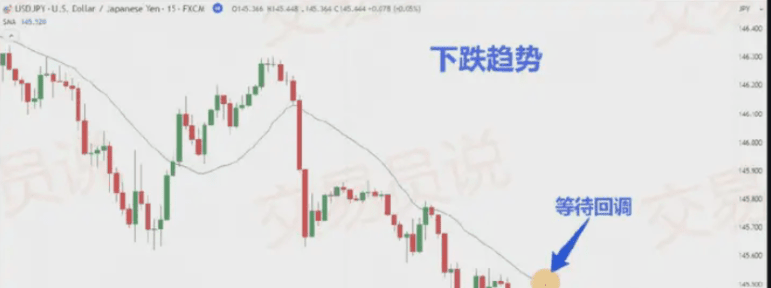
4. Entry confirmation.
There are two ways to confirm an entry: using price action or technical indicators.
◎ Price action confirmation: Observe chart patterns or candlestick patterns. Common chart patterns include double tops/double bottoms, head and shoulders top/head and shoulders bottom, triple tops/triple bottoms, etc. Common candlestick patterns include engulfing patterns, pin bars, inside bars, etc.
◎ Technical indicator confirmation: Tools such as stochastic indicators, relative strength index (RSI), MACD, etc. can be used.
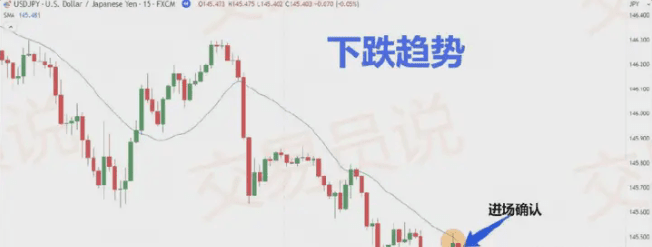
When using this trading strategy, be sure to focus on the following aspects:
1. Only enter the market when it is trending.
Entering trades when the market is in a clear and established trend can significantly increase the probability of trading success. Prices are more likely to continue in their original direction, which is advantageous for traders to operate with existing momentum. Conversely, trying to trade in a non-trending or volatile market can make price movements unpredictable and lead to unfavorable trading results.
2. Avoid counter-trend trading.
Counter-trend trading carries high risks. Counter-trend operations mean that traders are betting that the market will reverse its current direction, which requires very precise timing and strong reversal signals as a basis.
3. Enter during active trading hours.
Active trading hours typically coincide with the overlapping times of major markets, such as when the London market and New York market are open simultaneously. Trading during these hours offers better opportunities because the trading volume and price volatility are relatively higher, leading to tighter bid-ask spreads, less slippage, and better execution quality.
In contrast, trading during low activity periods (such as the Asian session, weekends, or holidays) may face wider spreads and lower liquidity, making trade execution more difficult.
Is the 20 EMA suitable for intraday trading?
The answer is affirmative. The 20 EMA is not only suitable for scalping trades but also for intraday trading. However, in intraday trading, you usually need to wait for specific patterns to appear before entering the market, and once you find such a pattern, you should confirm it with support and resistance levels. This pattern is actually quite easy to identify.
You should see a strong upward or downward movement within the first two hours after the market opens, followed by a price pullback to the 20 EMA. Remember, to maintain the effectiveness of this strategy, you also need to confirm the trend direction on a higher time frame. If the trend on the higher time frame is consistent with the earlier movement, the probability of price reversing near the 20 EMA is very high.
Will the 20 EMA strategy fail? Backtesting results tell you.
Like any other trading strategy, the 20 EMA is not perfect; it may fail. Sometimes, prices do reach support or resistance levels but still consolidate; prices may even ignore the 20 EMA line and fluctuate back and forth. If you encounter this situation, it’s best to pause trading and patiently wait for the next opportunity, as this market environment is full of uncertainty.
For the intraday trading 20 EMA strategy, a week of backtesting was conducted from March 5, 2025, to March 12, 2025. The results showed that while the strategy may fail in some cases, it overall still achieved positive returns.
Specific details are as follows:
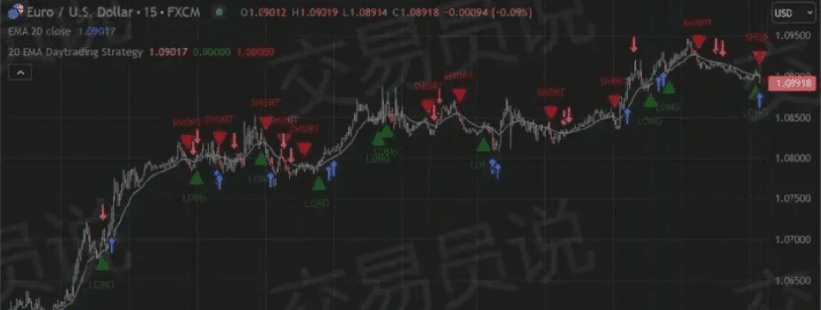
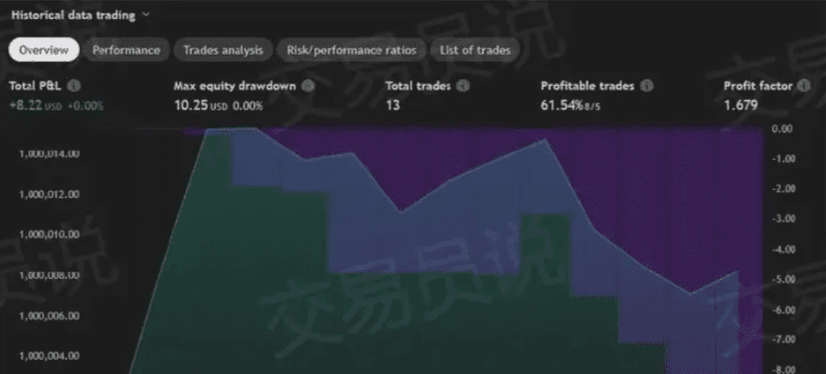
Over a week, 13 trades were made, validating the 20 EMA strategy as an intraday trading system. More importantly, the strategy achieved a 61.54% win rate and brought a total profit of $8.22.
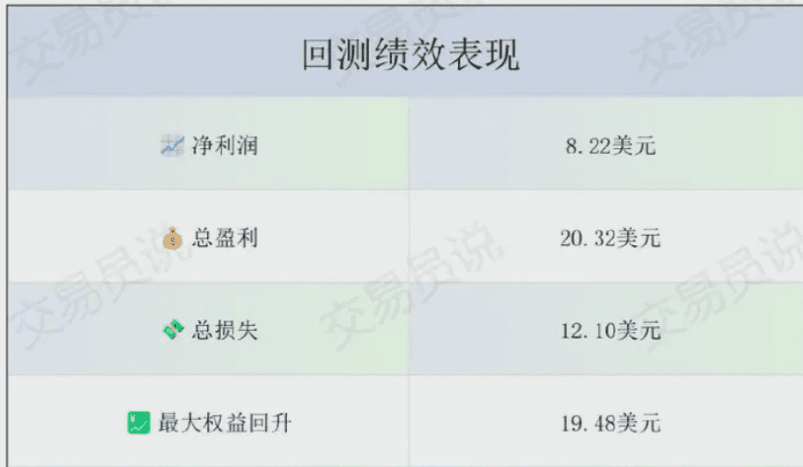
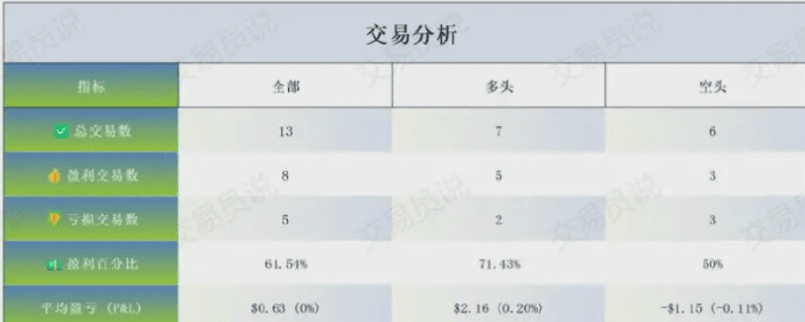
Technical conclusions.
The 20 EMA trading strategy is a simple yet powerful strategy. Compared to the SMA (Simple Moving Average), the EMA (Exponential Moving Average) is more closely aligned with price fluctuations, allowing it to display a more accurate 'rebound line' on the chart.
This strategy is simple enough for even novice traders to quickly get started and is quite effective for short-term trading on the 15-minute chart. But remember, it’s best to confirm the trend on the daily chart first, and pay attention to support and resistance areas.
Even if the 20 EMA strategy may fail at times, you can improve your win rate by analyzing multiple time frames and adding more tools to the chart. Moreover, if you trade in the major trend direction confirmed on the daily chart, the overall probability of profit remains high.
Although it may take some time to fully master this method, it is certainly worth trying. More importantly, you should first test this strategy in a forex demo account before applying it to a live account.
As an old trader who has been in the crypto market, I have summarized a few iron rules for trading coins today, each one being a lesson learned from blood and tears. After reading this, you can save yourself from losing 100,000!
1. East-West time difference: Stay up late to monitor the crypto market, which is mainly concentrated during European and American hours (Beijing time 21:30-7:30); the early hours are when prices usually rise! So, if you want to make money? Staying up late is a must! Sleep at 20:00, wake up at 4:00 to monitor the market; this is the schedule of a qualified trader.
2. Don't panic during a big drop in the daytime: Foreigners pull the market up at night after a drop during the day? Don't be afraid! At 21:30 at night, when foreigners enter, they can pull it back in minutes! Remember: a big drop during the day is an opportunity to buy the dip, and don't chase after a rise during the day; it's likely to drop back at night.
3. The deeper the pin, the stronger the signal: K-line pins (long upper and lower shadows) are a common tactic used by market makers; the deeper the pin, the stronger the reverse signal!
A pin bar often indicates the best time to buy or sell; don't be fooled by market makers to exit!
4. News landing is a negative signal: Before major meetings or positive news, the price will definitely rise, but once the news is released, it will immediately fall back! So, set up in advance, and once the news comes out, run quickly; don't be greedy!
5. Heavy positions will lead to liquidation; light positions are the way to go: Holding heavy positions? Congratulations, you are now on the exchange's liquidation list! The market makers are only watching heavy position users, pulling up and crashing down, and in a minute they can liquidate you! So, diversify and hold light positions to survive!
6. Stop losses lead to drops, taking profits leads to rises: When short stop losses are triggered, the price drops; when profits are taken, the price rises. The market makers just don't want you to make money! So, stop-losses should be cautious, and take profits should be done in batches. Don't let market makers lead you by the nose!
7. Getting out of a loss is just around the corner: Stop dreaming: getting out soon? The rebound suddenly stopped! How could the market makers let you escape easily? So, when close to breaking even, reduce your position appropriately, don't be greedy!
8. Excitement = waterfall warning: When you are extremely excited, the waterfall is about to come! Market makers use your emotions to harvest retail investors, so staying calm is the way to go!
9. When you have no money, but the market is full of opportunities: When you are broke, every coin seems to be rising, and FOMO emotions run high! But remember, 80% of the market is manipulated; don't jump in easily. Patience is the key to winning!
How can one achieve long-term survival in the crypto market? To survive and succeed in the crypto market for the long term,
You can follow these key strategies:
1. Risk management.
Use spare money for investment and avoid using high leverage or loans.
Set a stop-loss point, and once the preset loss limit is reached, sell decisively to avoid further losses.
2. Investment strategy.
Diversify your investments: Don't put all your funds into one project, but rather diversify across different coins and projects to reduce risk. Long-term holding: For quality projects, hold for a longer period to take advantage of the compound effect for wealth growth. Sell at the right time: If there is a significant negative news at market highs, it may be a good time to sell.
3. Information acquisition and processing.
Establish your own information sources, such as CoinMarketCap+, Defllama+, etc., to obtain accurate market data.
Learn to distinguish the authenticity of information to avoid being misled by false information.
4. Psychological adjustment.
Stay calm and not be influenced by the market's short-term fluctuations.
Set realistic expectations to avoid overtrading and frequent operations.
5. Continue learning.
Regularly learn about blockchain technology and knowledge related to digital currency, keep up with industry developments, participate in community discussions, and exchange experiences with other investors to broaden your horizons.
6. Balance life and investment.
Ensure that investment activities do not interfere with daily life and health.
Maintaining physical and mental health helps better cope with challenges in the investment process.
That's the trading experience shared by Awen. Many times, because of doubt about missing money-making opportunities, if you don't try or understand, how can you tell the good from the bad? You have to take the first step to know how to proceed next. I can be your teacher or your friend; feel free to reach out with questions. Still, that saying goes, if you don't know what to do in a bull market, click on Awen's avatar, follow for market planning, contract passwords, and free sharing.
\u003cc-435/\u003e
\u003cc-152/\u003e
\u003cc-335/\u003e
